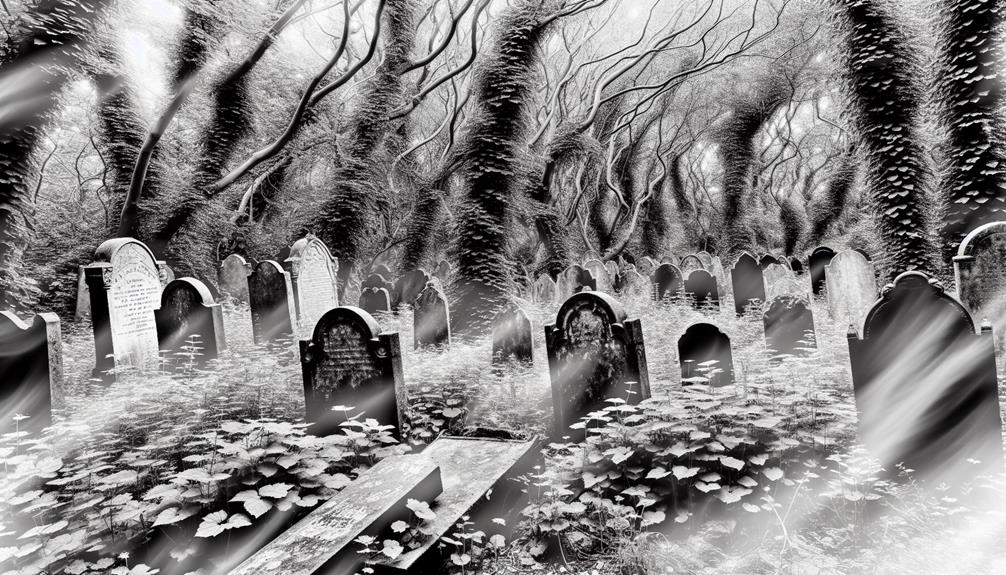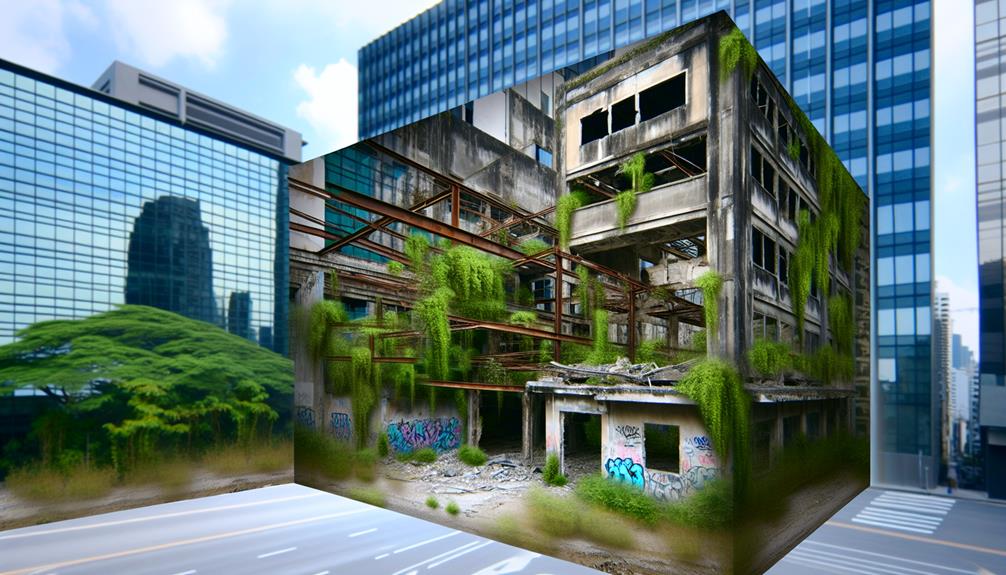Nestled within the Namib Desert, Kolmanskop in Namibia stands as a poignant proof of a bygone era of prosperity and industry. The abandoned town, once a thriving hub of diamond mining activity, now lies forgotten amidst the sands, frozen in time. Its dilapidated buildings and eerie atmosphere draw visitors from far and wide, offering a glimpse into a world long past. But what secrets do these deserted structures hold, and what tales of wealth and loss whisper through the desert winds, waiting to be discovered?
Key Takeaways
- Witness the decay of a diamond mining town frozen in time.
- Explore German colonial and Victorian architecture in a haunting setting.
- Experience the eerie beauty of abandoned buildings in the Namib Desert.
- Capture stunning photography with tips like rule of thirds and leading lines.
- Gain insight into the past life of Kolmanskop through urban exploration.
History of Kolmanskop
Kolmanskop, located in the Namib Desert, has a rich history deeply intertwined with the diamond mining industry that thrived in the early 20th century. Initially established by German settlers in the late 19th century, Kolmanskop flourished as a diamond mining town, attracting fortune seekers and entrepreneurs from around the world. The German influence is still visible in the architectural style of the buildings in the town, reflecting a mix of European design and desert practicality.
However, the success of Kolmanskop was short-lived, as the desert began to reclaim the land due to desertification effects. The shifting sands encroached on the town, burying houses, shops, and streets under layers of sand, creating a surreal landscape that stands as a confirmation to the power of nature. Desertification, exacerbated by human activities such as mining and deforestation, led to the abandonment of Kolmanskop as diamond production declined, leaving behind a ghost town frozen in time.
The legacy of Kolmanskop serves as a poignant reminder of the transient nature of wealth and the fragility of ecosystems. It prompts reflection on the impact of human actions on the environment and the importance of sustainable practices to prevent similar fates for other communities worldwide. As we explore the history of Kolmanskop, we are confronted with the consequences of unchecked exploitation and the necessity of responsible stewardship of our natural resources.
Diamond Mining Boom
What were the key factors that led to the rapid expansion of the diamond mining industry in Kolmanskop during the early 20th century? The diamond mining boom in Kolmanskop was fueled by several vital factors:
- Abundance of Diamond Deposits: Kolmanskop was situated in the Sperrgebiet area, known for its rich diamond deposits, attracting prospectors and mining companies.
- Technological Advancements: The introduction of advanced mining technologies enabled more efficient extraction of diamonds, contributing to increased production.
- Rising Demand for Diamonds: The growing global demand for diamonds, especially during the early 20th century, provided a lucrative market for the mined diamonds from Kolmanskop.
- Labor Supply: The availability of a workforce willing to work in the harsh desert conditions of Kolmanskop ensured that mining operations could be sustained.
- Diamond Smuggling: The illicit trade of diamonds, including smuggling, played a significant role in the expansion of the diamond mining industry in Kolmanskop, driving profits and increasing production.
The economic impact of this diamond mining boom was profound. It brought wealth to the region, attracting settlers and leading to the development of infrastructure and services in Kolmanskop. However, the shadow of diamond smuggling also cast a dark cloud over the industry, impacting the legal trade and raising ethical concerns.
Abandoned Buildings and Architecture
The legacy of the diamond mining boom in Kolmanskop is vividly captured in the abandoned buildings and unique architecture that dot the landscape, reflecting a bygone era of prosperity and industry. These structures, once bustling with activity, now stand frozen in time, offering a glimpse into the past through their intricate architectural details. The buildings in Kolmanskop showcase a blend of German colonial and Victorian influences, with ornate facades, arched doorways, and grand windows that speak to the aspirations of the town's early inhabitants.
Urban exploration in Kolmanskop provides a fascinating opportunity to wander through deserted homes, schools, and other establishments, each revealing a different aspect of life during the town's heyday. Inside these abandoned buildings, peeling paint, decaying furniture, and faded wallpaper create a haunting yet mesmerizing atmosphere, inviting visitors to imagine the stories of the people who once called this place home. The play of light and shadow in these deserted spaces adds an element of mystery and intrigue, emphasizing the beauty that can be found in decay.
Photography Tips and Tricks
Utilize strategic composition techniques to capture the haunting beauty and essence of Kolmanskop's abandoned buildings through photography. When photographing the eerie yet mesmerizing structures of Kolmanskop, consider the following photography tips and tricks:
- Rule of Thirds: Place the main subject off-center to create a more dynamic and visually appealing composition.
- Leading Lines: Use the lines of the buildings and shadows to lead the viewer's eye through the image towards the focal point.
- Frame Within a Frame: Capture the abandoned buildings through doorways, windows, or other structures to add depth and interest to your photographs.
- Contrast: Highlight the contrast between light and shadow to enhance the mysterious and haunting atmosphere of Kolmanskop.
- Golden Hour: Make the most of the soft, warm light during sunrise or sunset to add a magical touch to your photos and bring out the texture of the weathered buildings.
Visiting Kolmanskop Today
Exploring Kolmanskop today offers visitors a unique opportunity to step back in time and witness firsthand the fascinating decay and history of this once-thriving diamond mining town. Nestled in the heart of the Namib Desert, Kolmanskop stands as a proof of the passage of time and the relentless forces of nature. The town, now a ghost town, was once a bustling hub of activity where diamond miners and their families sought their fortunes.
Visitors to Kolmanskop can wander through the abandoned buildings, marveling at the intricate architecture that still stands despite years of neglect. The crumbling facades and sand-filled rooms offer a glimpse into the past, allowing visitors to imagine what life was like in this remote desert outpost. Exploring the ruins of Kolmanskop is a haunting experience, with each building telling a story of the town's rise and fall.
The surrounding desert landscapes further add to the surreal beauty of Kolmanskop. The shifting sands have slowly reclaimed the town, swallowing buildings whole and creating a stark contrast between man-made structures and the natural environment. As visitors wander through the deserted streets, they can't help but be struck by the eerie beauty of this abandoned place.
Frequently Asked Questions
Are There Any Ghost Sightings Reported in Kolmanskop?
Paranormal activity and rumors often spark interest in ghost sightings. Many locations worldwide capitalize on this fascination by offering ghost tours that claim to showcase supernatural encounters.
These tours attract visitors seeking a thrilling experience and a glimpse into the unknown. Reports of ghost sightings can create an aura of mystery and excitement, drawing in both believers and skeptics alike to explore the possibility of the existence of spirits in various locations.
Can Visitors Keep Any Diamonds They Find in the Area?
Diamond ownership regulations are strictly enforced in many regions to uphold fair distribution of resources and prevent illegal mining. Mining regulations typically dictate that any diamonds found within a specific area belong to the government or licensed mining companies.
Visitors are generally not allowed to keep any diamonds they find as ownership rights are tightly regulated to uphold legal standards and prevent exploitation of natural resources.
What Wildlife Can Be Found Around Kolmanskop?
In the desert ecosystem, wildlife conservation plays an essential role in preserving the delicate balance of the ecosystem. Bird watching and animal tracking are popular activities for enthusiasts who appreciate the diverse range of species that inhabit these arid regions.
Protecting the natural habitats of these animals is important for maintaining biodiversity and ensuring the survival of these unique species in their harsh desert environment.
Are There Any Guided Tours Available for Photography Enthusiasts?
For photography enthusiasts seeking to capture the essence of a desert landscape, there are guided tours and photography workshops available that offer a unique opportunity for desert exploration. These tours provide valuable insights into composition, lighting, and capturing the stark beauty of the desert environment.
Engaging in these workshops allows participants the freedom to express their creativity and hone their photography skills in a breathtaking setting.
How Has the Local Community Been Impacted by Kolmanskop's History?
The local community surrounding Kolmanskop has experienced both economic struggles and community resilience as a result of its history. The impact on the community's social dynamics and cultural heritage has been profound, shaping their identities and traditions.
Despite facing challenges, the community has shown remarkable resilience in preserving their heritage and finding ways to adapt. This complex interplay between history and community dynamics highlights the enduring legacy of Kolmanskop on the local residents.
Conclusion
To sum up, Kolmanskop stands as a mesmerizing time capsule of its diamond mining past, frozen in the sands of the Namib Desert.
The abandoned buildings, with their blend of German colonial and Victorian architecture, paint a haunting picture of a bygone era of prosperity.
The juxtaposition of eerie beauty and surreal desert landscapes creates a spellbinding atmosphere that transports visitors to a different time and place, like a faded photograph in the shifting sands of memory.


